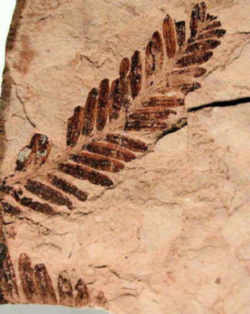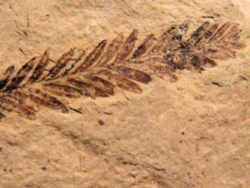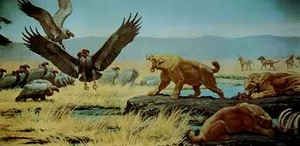Oregon State Fossil
Metasequoia

(Genus: Metasequoia)
Adopted on May 4, 2005.
The legislature designated the Metasequoia, or dawn redwood, as the official state fossil for Oregon by resolution on May 4, 2005.
After an intense effort by Newport fossil buff Guy DiTorrice (who once presented each and every legislator with a Metasequoia fossil) and student MacKenzie Smith, with the help of State Rep. Alan Brown, the Oregon legislature passed House Joint Resolution #3 on May 4, 2005. Honoring a fossil tree seemed appropriate to Oregon residents because it recognizes their timber heritage. Fossils of Metasequoia, commonly called "dawn redwoods"are abundant in Oregon's fossil record particularly near the Painted Hills and the towns of Mitchell and Fossil.
Oregon State Fossil: Metasequoia

Metasequoia, a deciduous conifer, and one of the common fossils found in many of the Eocene sites of the Pacific northwest, flourished in Oregon's forests for millions of years. In honor of this long history, Oregon has named it their official state fossil.
The Metasequoia flourished from the Oligocene into the Miocene Epoch 34 to 5 million years ago and left its record embedded in rocks across the Oregon landscape. The designation is part of a long-term economic, research and educational effort to draw attention to Oregon's paleontologic and geologic resources. While long extinct in Oregon, paleontologists discovered living 100-foot Metasequoia trees in a remote area of China over 50 years ago and brought specimens back to the United States for propagation, thus ensuring that live Metasequoia trees can be found today.

Metasequoia redwood fossils are known from many areas in the Northern Hemisphere; more than 20 fossil species have been named (some were even identified
as the genus Sequoia), but are considered as just three species, M. foxii, M. milleri, and M. occidentalis. During the Paleocene and Eocene,
extensive forests of Metasequoia occurred as far north as Strathcona Fiord on Ellesmere Island and sites on Axel Heiberg Island (northern Canada) at
around 80? N latitude. Metasequoia was likely deciduous by this time. Given that the high latitudes in this period were warm and tropical, it is hypothesized
that the deciduous habit evolved in response to the unusual light availability patterns, not to major seasonal variations in temperature. During three
months in the summer, the sun would shine continuously, while three months of the winter would be complete darkness. It is also hypothesized that the
change from evergreen to deciduous habit occurred before colonizing the high latitudes and was the reason Metasequoia was dominant in the north.
Large petrified trunks and stumps of the extinct Metasequoia occidentalis (sometimes identified as Sequoia occidentalis) also make
up the major portion of Tertiary fossil plant material in the badlands of western North Dakota.
The trees are well known from late Cretaceous to Miocene strata, but no fossils are known after that. Before its discovery, the taxon was believed
to have become extinct during the Miocene; when it was discovered extant, it was heralded as a "living fossil"
House Joint Resolution 3 Oregon Law 2005
HJR 3 (2005)
Metasequoia declared to be official fossil, HJR 3 (2005)
House Joint Resolution 3
Oregon Laws 2005
AN ACT
Whereas the State of Oregon has a state flag, a state animal (the beaver), a state flower (the Oregon grape), a state bird (the western meadowlark),
a state seal, a state tree (the Douglas fir), a state fish (the Chinook salmon), a state gemstone (the sunstone) and a state rock (the thunderegg);
and
Whereas the State of Oregon is the only state in the western half of the continental United States without an official state fossil and remains one
of only 16 states without such designation; and
Whereas a number of organizations and residents representing all areas of Oregon have been engaged in a long-term economic, research and educational
effort to draw attention to Oregon's paleontologic and geologic resources, and designation of an official state fossil will demonstrate support and
a visual image for that effort; and
Whereas the Metasequoia, or dawn redwood, is easily identified, is among the most abundantly found fossils in Oregon today and is widely distributed
in the fossil record of western North America; and
Whereas the Metasequoia represents Oregon's ancient past as it flourished in the Miocene epoch of 25 to 5 million years ago and left its record embedded
in rocks across the Oregon landscape despite volcanic explosions, deep lava flows and earthquakes; and
Whereas although the Metasequoia became extinct in Oregon five million years ago, paleontologists discovered living 100-foot Metasequoia trees in a
remote area of China over 50 years ago and brought specimens back to the United States for propagation, thus ensuring that live Metasequoia trees can
be found today; now, therefore,
Be It Resolved by the Legislative Assembly of the State of Oregon:
That the Metasequoia, the symbol of paleontologic and geologic interest that best represents Oregon's ancient past, is the official fossil of the State
of Oregon.
Filed in the Office of the Secretary of State May 12, 2005
Taxonomic Hierarchy: Metasequoia
Kingdom: Plantae
Division: Pinophyta
Class: Pinopsida
Order: Pinales
Family: Cupressaceae
Subfamily: Sequoioideae
Genus: Metasequoia Miki, 1941
Species:
†Metasequoia foxii
Metasequoia glyptostroboides
†Metasequoia milleri
†Metasequoia occidentalis
†Metasequoia disticha

Some states that lack a "state fossil" have nevertheless singled out a fossil for formal designation such as a state dinosaur, rock, gem or stone.







